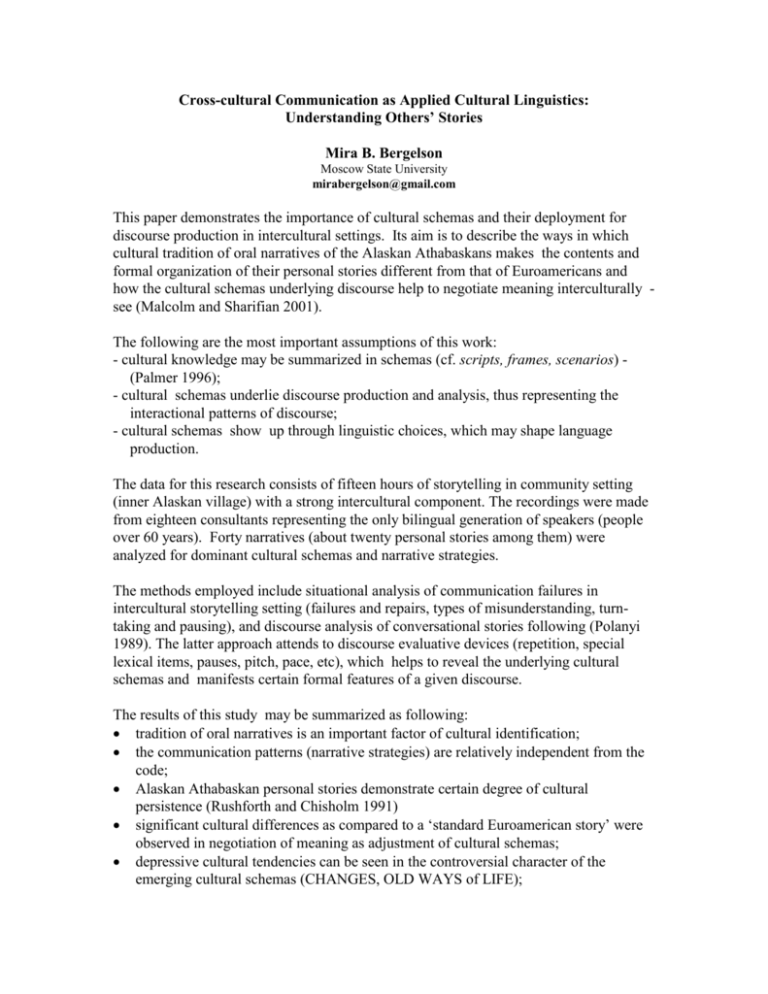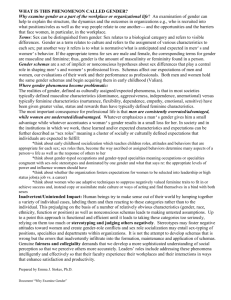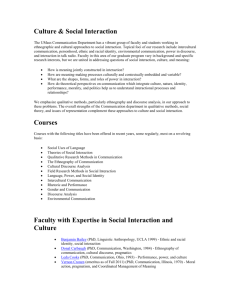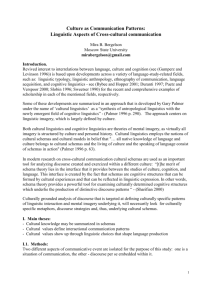This paper demonstrates the importance of cultural schemas and
advertisement

Cross-cultural Communication as Applied Cultural Linguistics: Understanding Others’ Stories Mira B. Bergelson Moscow State University mirabergelson@gmail.com This paper demonstrates the importance of cultural schemas and their deployment for discourse production in intercultural settings. Its aim is to describe the ways in which cultural tradition of oral narratives of the Alaskan Athabaskans makes the contents and formal organization of their personal stories different from that of Euroamericans and how the cultural schemas underlying discourse help to negotiate meaning interculturally see (Malcolm and Sharifian 2001). The following are the most important assumptions of this work: - cultural knowledge may be summarized in schemas (cf. scripts, frames, scenarios) (Palmer 1996); - cultural schemas underlie discourse production and analysis, thus representing the interactional patterns of discourse; - cultural schemas show up through linguistic choices, which may shape language production. The data for this research consists of fifteen hours of storytelling in community setting (inner Alaskan village) with a strong intercultural component. The recordings were made from eighteen consultants representing the only bilingual generation of speakers (people over 60 years). Forty narratives (about twenty personal stories among them) were analyzed for dominant cultural schemas and narrative strategies. The methods employed include situational analysis of communication failures in intercultural storytelling setting (failures and repairs, types of misunderstanding, turntaking and pausing), and discourse analysis of conversational stories following (Polanyi 1989). The latter approach attends to discourse evaluative devices (repetition, special lexical items, pauses, pitch, pace, etc), which helps to reveal the underlying cultural schemas and manifests certain formal features of a given discourse. The results of this study may be summarized as following: tradition of oral narratives is an important factor of cultural identification; the communication patterns (narrative strategies) are relatively independent from the code; Alaskan Athabaskan personal stories demonstrate certain degree of cultural persistence (Rushforth and Chisholm 1991) significant cultural differences as compared to a ‘standard Euroamerican story’ were observed in negotiation of meaning as adjustment of cultural schemas; depressive cultural tendencies can be seen in the controversial character of the emerging cultural schemas (CHANGES, OLD WAYS of LIFE); use of discourse markers and eh, you know (Fraser 1996) is different as compared to Euroamerican English-language narratives; intercultural aspects of communication are described in terms of applied cultural linguistics machinery, which allows for intercultural (cross-linguistic) comparisons. References. Fraser, B. (1996). “Pragmatic markers.” Pragmatics 6: 167-191. Malcolm, I. G. and F. Sharifian (2001). Aspects of Aboriginal English oral narrative: An application of cultural schema theory. 7th International Cognitive Linguistics Confrerence, University of California, Santa Barbara. Palmer, G. B. (1996). Toward a theory of cultural linguistics. Austin, University of Texas Press. Polanyi, L. (1989). Telling the American story : a structural and cultural analysis of conversational storytelling. Cambridge, Mass., MIT Press. Rushforth, S. and J. S. Chisholm (1991). Cultural persistence: Continuity in meaning and moral responsibility among the Bearlake Athapaskans. Tucson & London, The University of Arizona Press.











